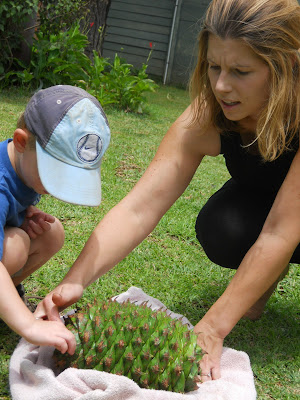A chameleon walked across the street in front of us today. Jonas and I
literally had to stop and wait for him to go past.... and if you have
ever seen a chameleon's crazy clamp-toed walk, it is not a fast thing.
While we were waiting, though, and while I tried to think of a witty "Why did the chameleon cross the road?" joke (unsuccessful), we noticed a pine cone that had recently fallen out of a monster sized Dr Suess-like pine tree that we regularly walk past. I walked over to pick it up and got about twenty sharp pokes when I laid my hands on it. I was not about to put my throbbing fingers around it again, but Jonas was soo enthusiastic that I returned to the stroller and got a towel to wrap around it. (As usual, there were a few amused Shona standing nearby, grinning and wondering what a crazy white lady thought she was going to do with a pine cone in a pink wrap.) I laughed at myself, waved to my on-lookers, and plopped it under the stroller, bringing it home with us like a lost puppy. When we got home, I carried my bulging pink towel into the bathroom much to the confusion of my husband. Ten and a half pounds. SOME PINECONE!!

Here Jonas checks out the sharp parts.



Indeed, I would argue that many plants here seem to be on steroids. They are strange versions of flora I used to know back in the States, but always much much bigger! Here are some other examples, found in our own garden:
Here our geraniums are over five feet tall, and have taken over a number of bushes.
Kurt standing in front of what looks like a house plant... but is actually a giant aloe relative.


Above: Believe it or not, these are poinsettias -the little Christmas plants found in pots! They grow into large trees here, and have to be trimmed often because of their fast growth. This picture was taken in August (winter here). Of course, now that the holidays are upon us, the trees are green and leafy and full of lizards... can't even get a tree in the Christmas spirit here!













.JPG)





























